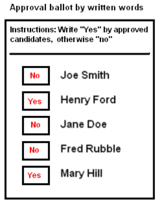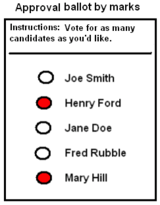Approval ballot
An approval ballot[1] is a ballot in which a voter may mark their ballots for any number of candidates simultaneously, rather than for only choosing one candidate. With an approval ballot, for each race, the voter is given a list of candidates to approve and decides whether to approve the candidate or disapprove of the candidate. Usually disapproval is indicated by letting the voter place a mark next to the names of candidates they approve, and assuming that unmarked candidates are disapproved.[2]
Candidates that are selected in a voter's ballot are said to be approved by the voter; the other candidates are said to be disapproved or rejected. Approval ballots do not let the voters specify a preference-order among the candidates they approve; hence this ballot is sometimes called an unordered ballot (in contrast to other ballot types).[3]
Approval ballots are used by approval voting, explicit approval voting, proportional approval voting, and combined approval voting, among other systems.
Description
Approval voting ballots show a list of the candidates running for that seat for each office being contested. Next to each name is a checkbox (or another similar way to mark "Yes" or "No" for that candidate).
Each candidate may be treated as a separate question: "Do you approve of this person for the job?" Approval voting lets each voter indicate support for one, some, or all candidates.
Each ballot separates candidates into two groups: those supported and those that are not. Each candidate approved is considered preferred to any candidate not approved, while the voter's preferences among approved candidates is unspecified, and likewise, the voter's preferences among unapproved candidates is also unspecified.
Example
In typical approval elections, voters may express support for multiple candidates. For example, if Alicia, Brandon, Charlie, David, and Eileen are running against each other, a voter may express support for Alicia and Eileen with the following ballot.
Alicia☑ Brandon☐ Charlie☐ David☐ Eileen☑
Usage
There are several electoral systems that use approval balloting; they differ in the way in which the election outcome is determined:
- In approval voting, there is a single winner, and he/she is the candidate with the largest number of votes.
- In bloc voting, (sometimes called "multiple non-transferable vote") there is a fixed number (say k) of winners, and they are the k candidates with the largest number of votes.
- In other multiwinner approval voting systems, there is a fixed numbe k of winners, but they are determined by more complex procedures, in order to guarantee such properties as justified representation.
Approval ballots let the voters express simple "yes" or "no" preferences (sometimes referred to as "dichotomous preferences")
Ballot types
Approval ballots can be of at least four semi-distinct forms. The simplest form is a blank ballot on which voters hand-write the names of the candidates they support. A more structured ballot lists all candidates, and voters mark each candidate they support. A more explicit structured ballot can list the candidates and provide two choices by each. (Candidate list ballots can include spaces for write-in candidates as well.)
All four ballots are theoretically equivalent. The more structured ballots may aid voters in offering clear votes so they explicitly know all their choices. The Yes/No format can help to detect an "undervote" when a candidate is left unmarked and allow the voter a second chance to confirm the ballot markings are correct. The "single bubble" format is incapable of producing invalid ballots (which might otherwise be rejected in counting).
Unless the second or fourth format is used, fraudulently adding votes to an approval voting ballot does not invalidate the ballot (that is, it does not make it appear inconsistent). Thus, approval voting raises the importance of ensuring that the "chain of custody" of ballots is secure.

|

|

|

|
References
- ↑ Duddy, Conal (2014-07-01). "Electing a representative committee by approval ballot: An impossibility result". Economics Letters. 124 (1): 14–16. doi:10.1016/j.econlet.2014.04.009. ISSN 0165-1765.
- ↑ Note that this article was derived from the article of the same name on English Wikipedia on August 16, 2022: https://en.wikipedia.org/w/index.php?title=Approval_ballot&oldid=1085372153
- ↑ Janson, Svante (2018-10-12). "Phragmen's and Thiele's election methods". arXiv:1611.08826 [math.HO].
